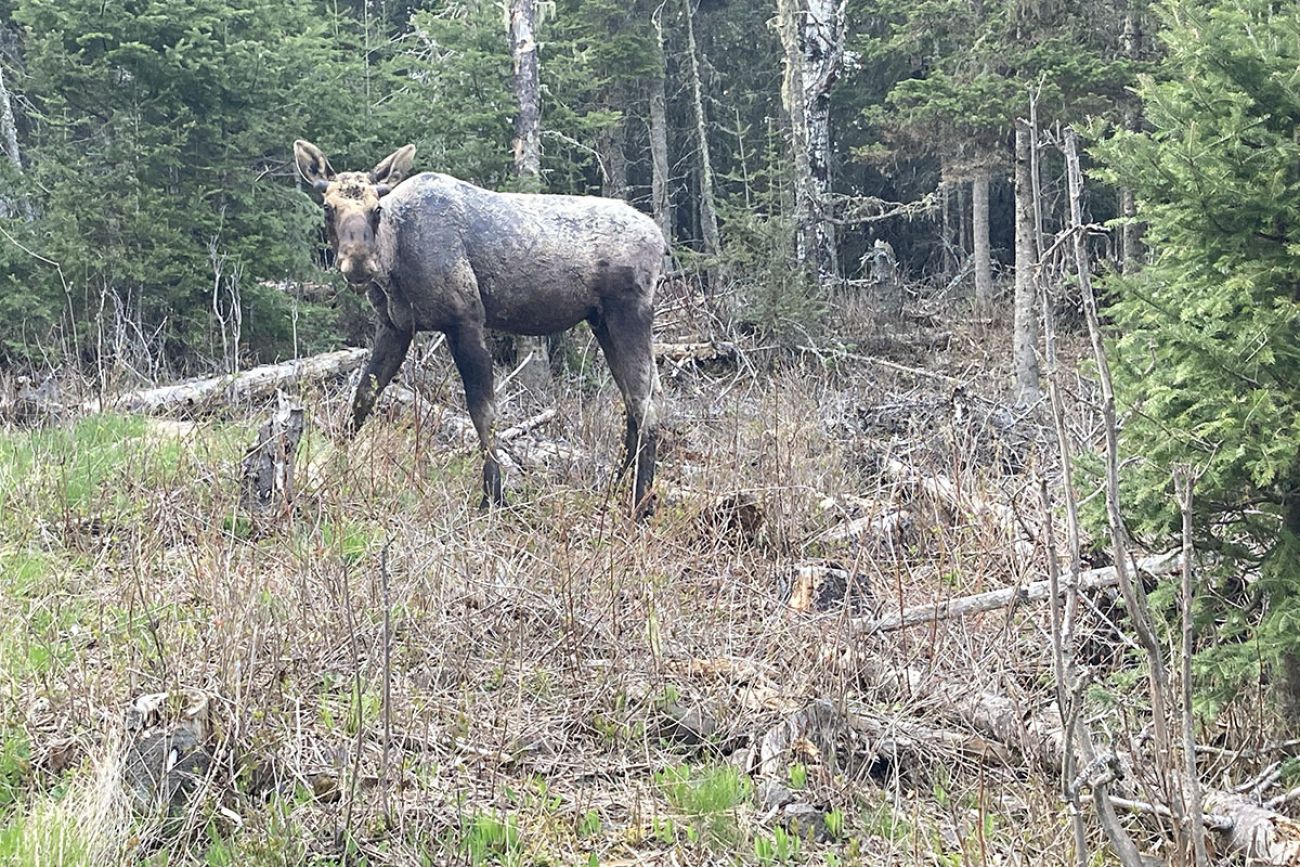Moose herds threatened by ticks, brain worms, the result of climate change

- Moose populations are being decimated in Minnesota, Maine, New Hampshire and other states as parasites their toll
- Michigan’s U.P. herds are remaining steady for now, thanks in part to severe winters in recent years
- But climate change is a longer-term threat, warming winters and allowing ticks and brain worms to thrive
At a time when moose populations in Minnesota and other states are plummeting, Michigan’s stagnant moose levels may seem like a small victory.
But wildlife experts say sharp declines are on the horizon as climate change delivers shorter, milder winters that make moose more susceptible to deadly ticks and brain worms.
“It’s hard to see things change that quickly, but I think there absolutely is more of a longer term concern for what the changes in the environment look like in terms of our moose population,” Chad Stewart, a deer, elk and moose specialist at the Michigan Department of Natural Resources, told Bridge Michigan.
Related:
- Whitmer asks Biden for disaster declaration in western U.P. because of floods
- Michigan bills would give farmers ‘right to repair’ tractors, equipment
- Michigan is the king of potato chips. But a disease is killing state spuds
“Whether it’s warming trends or anything else that could impact their potential for survival, I think that’s absolutely something that is worth keeping an eye on.”
Michigan’s moose population forages across 1,400-square-miles in Marquette, Baraga and Iron counties in the western Upper Peninsula. (There is also a small population in four eastern U.P. counties.)
Earlier this month, DNR released its first aerial moose population survey in four years, after a hiatus earlier in the COVID-19 pandemic. Officials counted 426 moose in the western U.P., a drop from 509 in 2019. Wildlife officials call the decline “statistically insignificant” because it’s based on a sampling that serves as a very rough estimate.
Stewart said he still has a positive outlook and called the herd’s stability over the four-year period a success, though he said there is probably disappointment within the DNR that the herd hadn’t increased.
Trends are far worse in other northern states, where adult moose and calves are being attacked more frequently by winter ticks (often called moose ticks) and brain worms commonly found on white-tail deer.
Maine, which holds the largest moose population in the lower 48 states, saw 90 percent of its calf population killed in winter 2021-2022 because of winter ticks.
Winter ticks are different from dog or deer ticks as they attach to their hosts by the thousands, rather than just one or two. Each tick can grow to nearly the size of a quarter as it feeds off the moose’s blood for months.
The best defense is a long, frigid winter, which can kill the pest as they shed from their host. But those are growing more rare as climate change warms the Great Lakes region, and ticks are thriving as a result.
A 2018 study by the University of New Hampshire found that of 179 radio-tagged moose calves, only 54 survived over a three-year period. More than 40,000 ticks were found on each dead calf, “causing emaciation and severe metabolic imbalance from blood loss.”
Seth Moore, natural resources director for the Grand Portage Band of Lake Superior Chippewa, which is leading research on moose populations, said the rising toll of tick infestations is a direct result of climate change. Winter is coming on later and spring is arriving earlier, leaving fewer cold, snow-covered days to kill off ticks.
Minnesota’s moose population is down 60 percent since 2009, from 8,000 to 3,200. Michelle Cartensen, a wildlife health supervisor at the Minnesota DNR, cited winter ticks and brain worms as a primary cause in the Northwest side of the state. On the northeast side, Cartensen said calf predation by wolves has depressed the population as well.
Brain worms are a hair-strand-sized pest that lodge in the brains of white-tail deer, though it does them no harm. Moose aren’t so lucky. Researchers say the parasites are transferred to moose through deer feces, which is eaten by snails and slugs, which in turn are ingested by moose as they graze on grass and plants.
Once inside the moose, the worms attack their neurological system, leaving the animals delirious and defenseless. Side effects of brain worms, Cartensen said, include disorientation — walking in circles or with a tilted head — and losing fear of humans.
Vallen Cook, an air quality specialist with the Grand Portage Band of Lake Superior Chippewa in Minnesota, recalled a close encounter with a moose that would have ordinarily put his life in danger. But because the moose had brain worm, he said, it just stared at him.
“When you’re that close to a moose, you better be scared and running, because they will charge you,” Cook said. “But he just sat there like there was nobody home.”
Stewart, of the Michigan DNR, said the U.P. 's recent cold winters helped keep the state’s moose population stable, for now.
“The Upper Peninsula, by all accounts, (had) what we considered a severe winter,” he said. “It started snowing pretty early and stayed for quite a while, they had a pretty substantial snowfall in May.”
Even so, noted Moore, more than a quarter of moose died this past winter from tick infestations on Isle Royale, an island national park in Lake Superior.
“We’ll see moose with 100,000 ticks on them,” Moore said.
Tyler Petroelje, a wildlife research specialist with Michigan DNR, said aside from its biennial population survey, research on Michigan moose is limited to retrieving those killed in vehicle crashes and analyzing their health and wellness before they died. He said radio-collared studies of Michigan moose haven’t been done since the early 2000s.
“Collaring is a very expensive endeavor,” he said. “We’d have to really have a reason to say, ‘Okay, we have concern for our moose population that it’s on the decline.’”
White-tail deer were once rare in the dense forests of northern Minnesota and the U.P. before European settlement. But extensive logging opened up new habitat, prompting deer to move northward. Milder winters exacerbate the trend. Now deer easily outnumber moose, allowing brain worms to spread easily.
While moose are native to Michigan, they were wiped out in the Lower Peninsula and barely hung on in the U.P.
In the 1930s, there was a failed effort to introduce more moose to the U.P. Officials were more successful in the 1980s, when about 60 moose were transported to Marquette County from Ontario. The goal was to reach 1,000 or more free-range, self-sustaining moose by 2000, a target that fell short.
Stewart called the western U.P. a perfect moose habitat due to its swampy understories and conifer trees.
Bridge reporter Kelly House contributed to this report.
Reporting for this story was made possible, in part, by a fellowship with the Institute for Journalism & Natural Resources.
Michigan Environment Watch
Michigan Environment Watch examines how public policy, industry, and other factors interact with the state’s trove of natural resources.
- See full coverage
- Subscribe
- Share tips and questions with Bridge environment reporter Kelly House
Michigan Environment Watch is made possible by generous financial support from:
Our generous Environment Watch underwriters encourage Bridge Michigan readers to also support civic journalism by becoming Bridge members. Please consider joining today.
See what new members are saying about why they donated to Bridge Michigan:
- “In order for this information to be accurate and unbiased it must be underwritten by its readers, not by special interests.” - Larry S.
- “Not many other media sources report on the topics Bridge does.” - Susan B.
- “Your journalism is outstanding and rare these days.” - Mark S.
If you want to ensure the future of nonpartisan, nonprofit Michigan journalism, please become a member today. You, too, will be asked why you donated and maybe we'll feature your quote next time!






